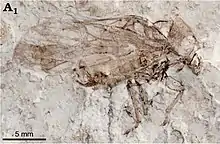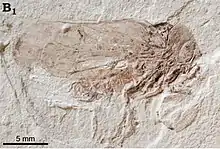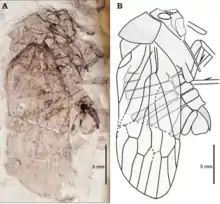Sanmai (genus)
Sanmai is an extinct genus of tettigarctid cicada from the middle Jurassic Epoch. The name is derived from the Mandarin san (three) and mai (branch) in reference to a certain vein of the wing being three-branched. This feature is also found in Architettix, a related fossil cicada genus. Sanmai currently contains three species. It undoubtedly belong to the subfamily Cicadoprosbolinae; however, placing it in a tribe has proved difficult. It is closely related to both Turutanoviini and Architettigini, and may be a transitional between the two. It is also possible it rests outside the two taxa, the similarities being convergent. Sanmai possesses "light and irregular speckles and lon-gitudinal stripes boldly contrasting to dark membrane, " which were likely designed to camouflage it from the many insectivourus creatures of the Daohugou Lagerstatte. The Daohugou Paleolake is part of the Jiulongshan Formation.[1]
| Sanmai | |
|---|---|
 | |
| Sanmai kongi holotype from the Jurassic of China | |
| Scientific classification | |
| Kingdom: | Animalia |
| Phylum: | Arthropoda |
| Class: | Insecta |
| Order: | Hemiptera |
| Family: | Tettigarctidae |
| Genus: | †Sanmai Chen et al., 2016 |
| Species | |
Species
The following species are attributed to this genus:
| Species | Notes | Image | Ref. |
|---|---|---|---|
| †Sanmai kongi | Named for the family name of Confucius, founder of Confucianism |  Sanmai kongi paratype STMN48-1801 |
[1] |
| †Sanmai mengi | Named for the family name of Mencius, a Sage of Confucianism. |  Sanmai mengi |
[1] |
| †Sanmai xuni | Named for the family name of Xuncius, a Sage of Confucianism |  Sanmai xuni |
[1] |
References
- Chen, Jun; Zhang, Haichun; Wang, Bo; Zheng, Yan; Wang, Xiaoli; Zheng, Xiaoting (2016). "New Jurassic tettigarctid cicadas from China with a novel example of disruptive coloration". Acta Palaeontologica Polonica. 61. doi:10.4202/app.00238.2015. ISSN 0567-7920. S2CID 59329301.